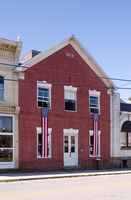 | Back to e-WV
| Back to e-WV
 The West Virginia Encyclopedia
The West Virginia Encyclopedia
 | Back to e-WV
| Back to e-WV
 The West Virginia Encyclopedia
The West Virginia Encyclopedia

The town of Beverly is located where Files Creek joins the Tygart Valley River as it flows toward Elkins, six miles to the north. Previously known as Edmonton, the village became the first county seat of Randolph County upon the county’s founding in 1787. It was renamed Beverly in honor of the governor of Virginia, Beverley Randolph, and chartered in 1790. Beverly was a political, economic, and social center of Randolph and surrounding counties until the loss of the county seat to Elkins in 1899.
Beverly, located on the Staunton-Parkersburg Turnpike, lay at a strategic highway junction. The Civil War, from the time of the nearby Battle of Rich Mountain in 1861 to Rosser’s Raid on the town in 1865, disrupted local life. Beverly suffered much damage in the course of the war, while serving as an important supply and command post for thousands of federal troops in eastern West Virginia.
Prominent citizens of Beverly have included Lemuel Chenoweth, the builder of covered bridges including the Philippi Bridge; West Virginia statehood leader John S. Carlile; and Laura Jackson Arnold, the sister of Thomas J. ‘‘Stonewall’’ Jackson. Today, the town is the location of Colonial Millworks, Armstrong Wood Floor, and a number of antique stores located in historic buildings. The Beverly Historic District was listed in the National Register of Historic Places in 1980. The Beverly Heritage Center serves as a museum and visitor center for the town.
In 2020, Beverly had a population of 628.
Read the National Register nomination.
Written by Donald L. Rice
Baxter, Phyllis & Donald L. Rice. Historic Beverly: A Guide Book. Elkins: Tom's Printing, 1993.
Bosworth, Albert S. History of Randolph County. Parsons: McClain, 1975.
Maxwell, Hu. History of Randolph County. Morgantown: Acme Pub., 1898.